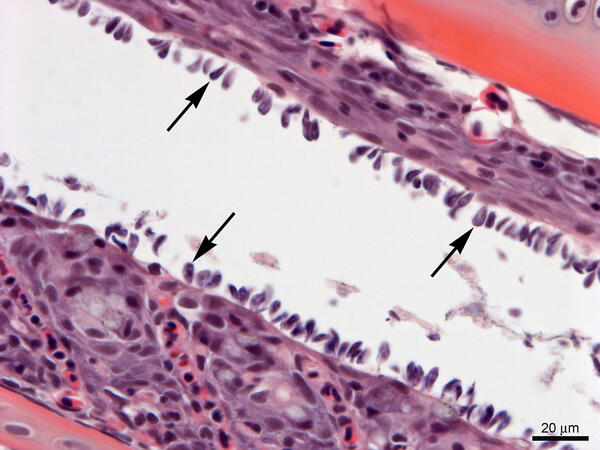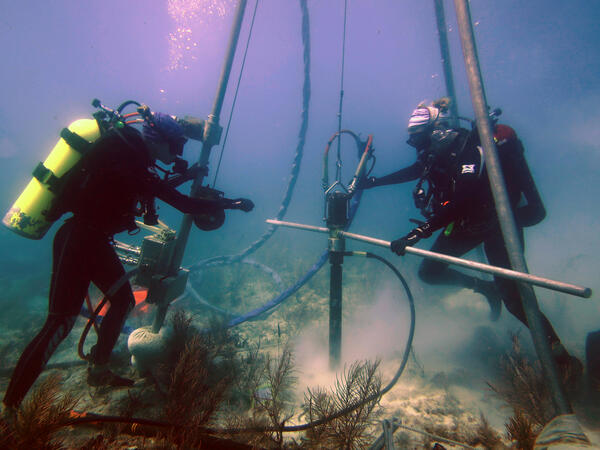In mid-July 2018, fissure 8 (shown here) on Kīlauea Volcano's lower East Rift Zone was emitting more than 50,000 tons of sulfur dioxide gas per day, creating high levels of vog on the island. Since early August, lower East Rift Zone SO2 emissions have dropped to less than 100 tons per day, resulting in better air quality for Hawaii.
Images
Explore our planet through photography and imagery, including climate change and water all the way back to the 1800s when the USGS was surveying the country by horse and buggy.
In mid-July 2018, fissure 8 (shown here) on Kīlauea Volcano's lower East Rift Zone was emitting more than 50,000 tons of sulfur dioxide gas per day, creating high levels of vog on the island. Since early August, lower East Rift Zone SO2 emissions have dropped to less than 100 tons per day, resulting in better air quality for Hawaii.
Two views from the Rainbow Falls overlook, downstream of the Wailuku River streamgage near Hilo, Hawaii. The image on the left shows a typical base flow of about 35 cubic feet per second (cfs). The image on the right shows the early impact of Hurricane Lane with a flow of about 26,000 cfs taken at 8:35 a.m. HST, August 23, 2018. This U.S.
Two views from the Rainbow Falls overlook, downstream of the Wailuku River streamgage near Hilo, Hawaii. The image on the left shows a typical base flow of about 35 cubic feet per second (cfs). The image on the right shows the early impact of Hurricane Lane with a flow of about 26,000 cfs taken at 8:35 a.m. HST, August 23, 2018. This U.S.
Skinny Common Murre with keel protruding. Lower Cook Inlet, Alaska
Skinny Common Murre with keel protruding. Lower Cook Inlet, Alaska
Unalakleet village on the low-lying barrier spit at the inlet of the Unalakleet River and Norton Sound, Alaska.
Unalakleet village on the low-lying barrier spit at the inlet of the Unalakleet River and Norton Sound, Alaska.

Many of the earthquakes in Hawaii that extend offshore and up the island chain are due to plate bending, or flexure. The upper panel shows magnitude-5 and greater earthquakes since 1861, with some notable events labeled.
Many of the earthquakes in Hawaii that extend offshore and up the island chain are due to plate bending, or flexure. The upper panel shows magnitude-5 and greater earthquakes since 1861, with some notable events labeled.

Gills from Lost River suckers with a heavy infestation of Ichthyobodo sp. (arrows). Slide is stained with hematoxylin and eosin.
Gills from Lost River suckers with a heavy infestation of Ichthyobodo sp. (arrows). Slide is stained with hematoxylin and eosin.

A Peregrine Falcon flies off with a Black-legged Kittiwake from its colony at Gull Island, Alaska.
A Peregrine Falcon flies off with a Black-legged Kittiwake from its colony at Gull Island, Alaska.

A USGS hydrologist documents a flooded street near the Sugar River in Verona, Wisconsin. This image was taken after the area received near-record rainfall on August 20, 2018.
A USGS hydrologist documents a flooded street near the Sugar River in Verona, Wisconsin. This image was taken after the area received near-record rainfall on August 20, 2018.

A total solar eclipse darkened the skies over the United States on Aug. 21, 2017.
Oshkosh, a town in the Nebraska Sandhills, was a prime location for viewing the eclipse. This Landsat 7 image shows the town at 11:33 a.m. local time on Aug. 18, 2016, a year before the total eclipse.
A total solar eclipse darkened the skies over the United States on Aug. 21, 2017.
Oshkosh, a town in the Nebraska Sandhills, was a prime location for viewing the eclipse. This Landsat 7 image shows the town at 11:33 a.m. local time on Aug. 18, 2016, a year before the total eclipse.
Twentymile River sonar on a bridge

Research Oceanographer Lauren Toth and student volunteer Liz Whitcher drill a coral-reef core from a reef off Key West, Florida, in the Florida Keys National Marine Sanctuary. Photo taken under research permit FKNMS-2015-058. Credit: Anastasios Stathakopoulos, USGS.
Research Oceanographer Lauren Toth and student volunteer Liz Whitcher drill a coral-reef core from a reef off Key West, Florida, in the Florida Keys National Marine Sanctuary. Photo taken under research permit FKNMS-2015-058. Credit: Anastasios Stathakopoulos, USGS.

This image shows citizen scientists along with National Park Service personnel identifying invertebrates as part of the Dragonfly Mercury Project.
This image shows citizen scientists along with National Park Service personnel identifying invertebrates as part of the Dragonfly Mercury Project.

Pu‘u ‘Ō‘ō on May 3, 2018, as viewed from the helicopter overflight. The crater floor is collapsed, and a thin plume escapes from the gaping crater. The west flank cracked on April 30th around 2:30 pm HST, and minor amounts of lava oozed out of the crack (line of steaming features) just before the plumbing system catastrophically failed.
Pu‘u ‘Ō‘ō on May 3, 2018, as viewed from the helicopter overflight. The crater floor is collapsed, and a thin plume escapes from the gaping crater. The west flank cracked on April 30th around 2:30 pm HST, and minor amounts of lava oozed out of the crack (line of steaming features) just before the plumbing system catastrophically failed.

A sensor data logger recovered from the floor of Yellowstone Lake in the Deep Hole area in 2018 shows signs of melting due to unexpectedly high temperatures in sediments up to ~3 ft (1 m) away from an active hydrothermal vent. Image acquired by the Global Foundation for Ocean Exploration ROV Yogi on August 4, 2018.
A sensor data logger recovered from the floor of Yellowstone Lake in the Deep Hole area in 2018 shows signs of melting due to unexpectedly high temperatures in sediments up to ~3 ft (1 m) away from an active hydrothermal vent. Image acquired by the Global Foundation for Ocean Exploration ROV Yogi on August 4, 2018.

Hot spring waters with relatively high dissolved element concentrations on the floor of West Thumb, Yellowstone Lake. Image acquired by the Global Foundation for Ocean Exploration ROV Yogi on August 7, 2018.
Hot spring waters with relatively high dissolved element concentrations on the floor of West Thumb, Yellowstone Lake. Image acquired by the Global Foundation for Ocean Exploration ROV Yogi on August 7, 2018.
Color bands in this radar interferogram depict the pattern of surface deformation at the Yellowstone caldera from September 22, 2004, to August 23, 2006. The southwest and northeast parts of the caldera floor rose about 11 cm (4.3 inches) and 15 cm (5.9 inches), respectively, while the north caldera rim near Norris Geyser Basin subsided about 7 cm (2.8 inches).
Color bands in this radar interferogram depict the pattern of surface deformation at the Yellowstone caldera from September 22, 2004, to August 23, 2006. The southwest and northeast parts of the caldera floor rose about 11 cm (4.3 inches) and 15 cm (5.9 inches), respectively, while the north caldera rim near Norris Geyser Basin subsided about 7 cm (2.8 inches).
Scientific crew and drone operators. Left to right: Richard Kolyer (NASA), Jack McFarland (USGS), Kristen Manies (USGS), and Jonas Jonsson (NASA)
Scientific crew and drone operators. Left to right: Richard Kolyer (NASA), Jack McFarland (USGS), Kristen Manies (USGS), and Jonas Jonsson (NASA)
At Kīlauea's summit today, a clear morning gave way to heavy rain, which re-mobilized the ash cover between HVO and the Southwest Rift Zone, concentrating the ash in washes.
At Kīlauea's summit today, a clear morning gave way to heavy rain, which re-mobilized the ash cover between HVO and the Southwest Rift Zone, concentrating the ash in washes.
USGS hydrologist Taylor Dudunake assesses the rip-rap countermeasure along the pier of the Iowa State Route 76 bridge over the Upper Iowa River near Dorchester, Iowa. The assessment was part of a nationwide study of bridge scour countermeasures the USGS conducted on behalf of the Federal Highway Administration.
USGS hydrologist Taylor Dudunake assesses the rip-rap countermeasure along the pier of the Iowa State Route 76 bridge over the Upper Iowa River near Dorchester, Iowa. The assessment was part of a nationwide study of bridge scour countermeasures the USGS conducted on behalf of the Federal Highway Administration.

Catherine Fargen and Moriah Will making a groundwater measurement.
Catherine Fargen and Moriah Will making a groundwater measurement.

Catherine Fargen and Moriah Will securing a well from floodwaters.
Catherine Fargen and Moriah Will securing a well from floodwaters.










